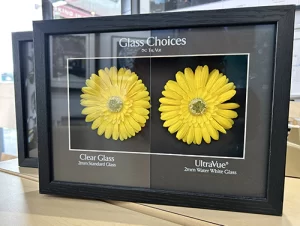While frames are designed to preserve and protect, they are not indestructible. Antique picture frames are often the most susceptible. As with anything, age tends to make the materials deteriorate, and sometimes minor alterations are needed.
Frames need to be delicately handled when transporting and re-hanging. Glass can easily break, and the corners of the frames can be damaged. It is particularly important to store frames face-to-face or back-to-back when leaning them against one another. The back screws and wire hangers can scratch the face of the frame if they are leaned back-to-front. Sometimes even with the most gentle handling, accidents happen. Our framers are able to repair all sorts of damage on all styles of frames.
TYPES OF GLAZING
There are a number of different types of glazing to choose from. If the artwork is in an area with high amounts of sunlight, UV-protective glass may be needed, or glass that is non-reflective. If the artwork is in an area where it will be susceptible to bumps, or jolts, such as a child’s room, Acrylic may be a better alternative to glass as it will not shatter or break.
[1] Regular glass has natural moderate UV protection. It is best suited for rooms that do not receive direct sunlight.
[2] Tru Vue UltraVue 70 & 92 Non-Reflective Glass has 70% or 92% UV protection and an anti-reflective water white finish. As a result, the glass has the same clarity as Museum Glass. UltraVue 70 & 92 are our most popular types of glass now. Most people buy this glass for the clarity and brilliance. It is almost invisible.
[3] Conservation Clear or UV glass will block out 97% of harmful UV light. This reduces the fading and muting of colours.
[4] Non-glare has an etched finish to eliminate the reflective surface of the glass. This is the “old school” fuzzy picture framing glass. Because of the etching and the fuzzy finish fine detail in the artwork can occasionally be lost. This glass works best for photographs or artwork with bold patterns or large shapes. Non-glare glazing can also come in a form with UV protection.
[5] Museum Glass is the primary glass used by national galleries. Because of its 99% UV protection, it will be the best option for ensuring that works of art are not damaged by sunlight. It also has an anti-reflective finish and is intended to mimic the invisibility of the glass used in prescription glasses.
[6] Acrylic is a form of thermoplastic and as a result, it is much lighter and slightly clearer than regular glass. Acrylic works best for larger pieces, as its weight will not place as much stress on the frame. Acrylic is much more durable than glass, and it will not shatter or even break, though it can get easily scratched. When transporting works of art, glass should not be included, or acrylic should be used in its place. If the frame will be in a high traffic area, or somewhere where it is likely to be bumped or jostled, acrylic would be highly recommended.




